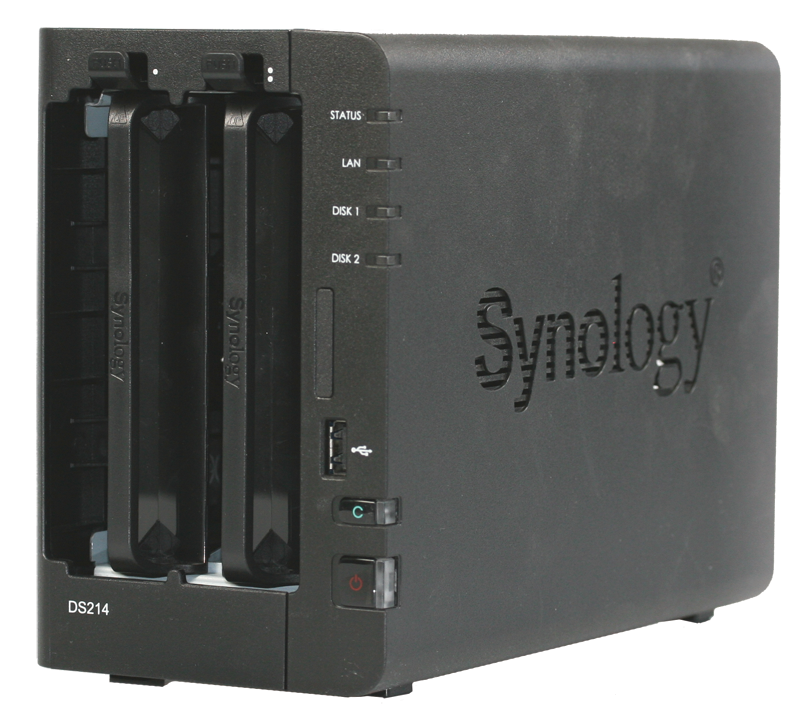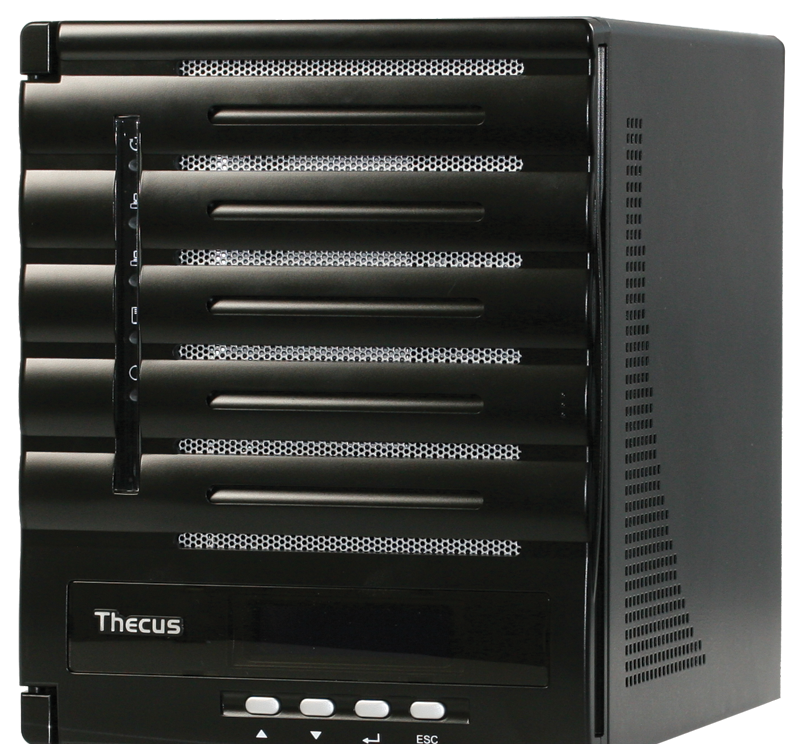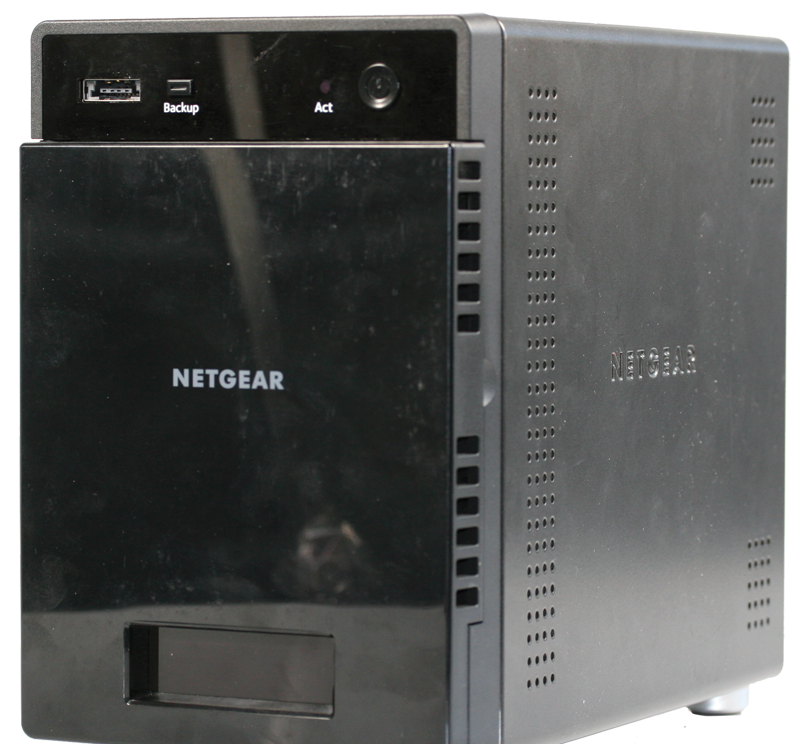
We compare four popular NAS appliances
Data Dance
Decentralization was the battle cry of the client-server revolution – away with the mainframe! Now the pendulum has swung back and ended up in the cloud. However, in these times of Amazon, Google, and NSA and of spectacular hacks with millions of stolen records, both private individuals and enterprises are fully aware that private data attracts unwanted attention. Some businesses prefer to keep their data at home. To combine the benefits of a central repository with the advantages of local control, you really need to run your own cloud. Is that possible? The ADMIN magazine team decided to test a few NAS appliances and see how far we could get.
We requested four NAS appliances from four manufacturers (Table 1). All of these products are also suitable for small businesses or larger departments. These products cost less than $1,000, including disks, and all are easy to manage, even without IT personnel.
Tabelle 1: Test Equipment Specifications
|
QNAP |
Synology |
Thecus |
Netgear |
|
|---|---|---|---|---|
|
Model |
TS-251 |
DS-214 |
N5550 |
ReadyNAS RN31400 |
|
Manufacturer |
QNAP Inc. |
Synology |
Thecus |
Netgear |
|
Operating System |
QTS 4.1.1 (Linux 3.12.6) |
DSM 5.0-4493 Update 5 (Linux 3.2.40) |
Thecus OS 5.0 (Linux 3.10.47) |
ReadyNAS OS 6.1.9 |
|
Price (without disks,EUR incl. VAT) |
$350/EUR390 |
$300/EUR250 |
$370/EUR430 |
$600/EUR675 |
|
Hardware |
||||
|
Processor |
Intel Celeron J1800, 2.41GHz (dual core) |
Marvell Armada XP (PJ4Bv7), 1.066GHz (dual core) |
Intel Atom D2550, 1.86GHz (dual core) |
Intel Atom D2701, 2.13GHz (dual core) |
|
RAM |
4GB |
0.5GB |
2GB |
2GB |
|
Network Interface |
2x 1Gbit Ethernet |
1x 1Gbit Ethernet |
2x 1Gbit Ethernet |
2x 1Gbit Ethernet |
|
Power Supplies |
External, In: 100-240 V/50-60 Hz; Out: 12 V/5 A |
External, In: 100-240 V/50-60 Hz; Out: 12 V/6 A |
Internal |
External, In: 100-240 V/50-60 Hz; Out: 12 V/7 A |
|
Disk Trays |
2 |
2 |
5 |
4 |
|
OS with Flash |
Yes |
No |
Yes |
No |
|
Disk Type |
3.5 and 2.5 inch |
3.5 and 2.5 inch |
3.5 and 2.5 inch |
3.5 and 2.5 inch |
|
Raid Level |
0/1/JBOD |
0/1/JBOD |
0/1/5/6/10/JBOD |
0/1/5/6/0/JBOD/XRAID 2 |
|
Spare Disk |
No |
No |
Yes |
Yes |
|
Filesystems (Internal HDs) |
ext4 |
ext4 |
ext3/ext4/XFS |
Btrfs |
|
USB 3.0 |
2x |
2x |
1x |
2x |
|
USB 2.0 |
2x |
1x |
4x |
1x |
|
eSATA |
No |
No |
Yes |
Yes |
|
HDMI |
Yes |
No |
Yes |
Yes |
|
VGA |
No |
No |
Yes |
No |
|
LCD Panel |
No |
No |
Yes |
Yes |
|
Form Factor |
Tower, 68x102x225mm |
Tower, 165x108x233mm |
Tower, 230x190x240mm |
Tower, 223x134x205mm |
QNAP
The prize for the best software level (Table 2) goes to the QNAP device. With about 130 internal apps, it has twice as many as direct competitor Synology. More is not always better, and you could argue in individual cases that not all of these small applications are justifiable. The selection, however, is huge; it includes 20 audio, video, and photo servers and applications for recording with surveillance cameras, as well as many backup applications that synchronize with cloud storage such as Amazon S3 and Dropbox.
Tabelle 2: Software Features
|
Basic Data |
QNAP |
Synology |
Thecus |
Netgear |
|---|---|---|---|---|
|
Encryption |
AES 256 Bit, Volume Based |
Folder Based |
Yes |
AES 256 Bit, Drive Based |
|
Compression |
No |
No |
No |
Yes |
|
Deduplication |
No |
No |
No |
No |
|
Replication |
No |
Yes, NAS to NAS |
Yes |
Yes |
|
Snapshot |
No |
No |
Yes |
Yes |
|
Antivirus |
Yes |
Yes |
Yes |
Yes |
|
Backup |
Yes |
Yes |
Yes |
Yes |
|
Web GUI |
Yes |
Yes |
Yes |
Yes |
|
Resource Monitor |
Yes |
Yes |
Yes |
Yes |
|
Logging |
Yes |
Yes |
Yes |
Yes |
|
SNMP |
Yes |
Yes |
Yes |
Yes |
|
S.M.A.R.T. |
Yes |
Yes |
Yes |
Yes |
|
No. of Apps Available |
130 |
60 |
121 |
77 |
Additionally, full-blown business applications are offered, such as stores or CRM systems, many CMSs (including Drupal, WordPress, Joomla, etc.), and databases such as PostgreSQL and MongoDB. Various utilities and development tools (Java, Perl, Python, etc.), download managers, educational programs, and communication tools are on board. Almost nothing has been left out, and sometimes you have a choice between two or three varieties.
The hardware is also powerful: It has a fast USB 3.0 interface and significantly more RAM than the competitors; finally, QNAP even gives you a fast processor with its NAS, securing it first place in terms of performance, too. However, good equipment, good features, and performance have their price; in relation to the number of disks, the QNAP is the most expensive device in the test field.
Synology
With about 60 apps, the NAS by Synology is not quite as feature-rich as the QNAP, but it's still solidly equipped. Everything you need is in place. In terms of performance, the appliance can keep up with the field, trailing just behind competitor QNAP in some disciplines and running just ahead in others. Additionally, it is the cheapest device in the test field.
Don't look for an HDMI port, though, which all the other test candidates have (Table 3), and the selection of USB ports is also not very generous. However, the web GUI with its stylish design and ease of use can compensate for gaps in other places.
Tabelle 3: Network and File Sharing Features
|
QNAP |
Synology |
Thecus |
Netgear |
|
|---|---|---|---|---|
|
Basic Data |
||||
|
IPv4 |
Yes |
Yes |
Yes |
Yes |
|
IPv6 |
Yes |
Yes |
Yes |
Yes |
|
Port trunking |
Yes |
No |
Yes |
Yes |
|
DHCP client |
Yes |
Yes |
Yes |
Yes |
|
SSH access |
Yes |
Yes |
Yes |
Yes |
|
LDAP server |
Yes |
Yes |
No |
Yes |
|
UPnP or Bonjour |
Yes |
Yes |
Yes |
Yes |
|
File Sharing |
||||
|
NFSv3 |
Yes |
Yes |
Yes |
Yes |
|
NFSv4 |
No |
Yes |
Yes |
Yes |
|
CIFS |
Yes |
Yes |
Yes |
Yes |
|
iSCSI |
Yes |
Yes |
Yes |
Yes |
|
AFP |
Yes |
Yes |
Yes |
Yes |
|
FTP |
Yes |
Yes |
Yes |
Yes |
|
TFTP |
Yes |
Yes |
Yes |
No |
The Synology and Netgear devices both store the operating system on the data disks, whereas it is preinstalled on safe storage with the QNAP and Thecus. Both approaches have advantages and disadvantages. Devices with a preinstalled OS are immediately configurable after inserting the disks; users with the other system first need to install the operating system from a local disk or off the Internet. Also, devices with a preinstalled OS are relatively safe from attacks, because the contents in memory cannot be easily overwritten. On the downside, knowledgeable users cannot modify the system easily to suit their own ideas.
Thecus
The Thecus device can offer a net capacity of around 15TB (RAID 5) with 4TB disks, or you can make do with 11TB and treat yourself to a global spare disk. This already makes the Thecus more suited for professional applications, such as central data storage for a small company or large department. Additionally, the NAS is pretty cheap; it only costs a little bit more than the two-disk solution by QNAP (without disks in all cases) despite having five disk trays.
Of course, you can't have everything and a good price. For example, the Atom CPU is not powerful enough to handle multiple parallel tasks, many small files, or many metadata operations, such as occur when you copy directory trees, for example.
However, the device by Thecus need not be modest in terms of its other hardware equipment; on the contrary, an eSATA port or an LCD panel is something that not every device has, and this is the only device to offer VGA output (in addition to HDMI).
The Thecus is the only device that lets the user choose freely between various filesystems for the internal volumes or lock the panels against unauthorized disk removal. Additionally, no other competitor has so many USB ports.
Netgear
The Netgear model has four disk trays and also allows the configuration of larger volumes. Like the Thecus model, it has an LCD display, but unlike it, no pushbuttons. You can thus quickly discover what IP address the device uses, but you cannot set the IP. Otherwise, the hardware equipment is good; however, the device is not cheap.
The Linux operating software, dubbed ReadyNAS OS here, left the testers somewhat ambivalent. On the one hand, it was the only device in our lab to use Btrfs by default as its NAS filesystem, and it passes on the benefits – such as the ability to grab snapshots – in full to the user. Elsewhere, however, the device is still somewhat immature. It produces completely cryptic error messages (e.g., 1013050001 pre_proc_add_share() failed with status=1), which we hope convey something to the developers but are virtually useless to users.
When attempting to download the ReadyNAS Remote Client on Linux, we were incorrectly offered the version for Mac OS – apparently, because there is no Linux version. This also means that Linux users cannot access their NAS from the outside if it resides behind a NAT router.
Additionally, problems with the GUI sends you through endless loops; for example, if you click Cloud in the top menubar of the main menu, you end up on a page that offers you three services: ReadyCloud, ReadyNASReplicate, and ReadyDROP. If you choose ReadyCloud, you are guided through device detection (Discover) and the Manage link, which are the only choices, then back to the main menu, where you can start over again. This doesn't make any sense, and although this annoyance does not keep you from using the device, but it does show some room for improvement.
Home-Grown
When looking at the test candidates some people might be asking: Can't I build something like this myself? Sure, you can. With a SoC like the Raspberry Pi, it could even have similar physical dimensions. The commercially available devices all take advantage of the free Linux operating system and rely on its standard tools; there is no wizardry involved here.
However, a hobbyist with a home-built device would have to do without a few features. You would not have a GUI for single-click installation and graphical configuration of selected applications, and the device could not be programmed without unreasonable overhead. Additionally, you would find it difficult to run services such as Dynamic DNS or the externally accessible internal server that allows users to connect from the web. An appealing case for the computer and hotplug-capable disks would be challenging, at least. Also, if you have problems, you would not be able to call the NAS manufacturer for support.
Thus, you probably gain little through DIY. Certainly some applications that you could imagine on a NAS have not yet found their way into the manufacturers' repositories, but these are special cases, and you might be able to solve them on a standard device after installing SSH access. On the other hand, doing so could void your warranty. For example, Netgear reserves the right to require a factory reset in case of support if the admin has enabled SSH access.
Benchmarks
For the main benchmarks, we turned to the Intel NAS Performance Toolkit (NASPT) [1], which was developed by the chip manufacturer for comparing NAS appliances, and which recreates workloads typical of applications in the home or small office. These include video playback with one, two, and four parallel streams (Figure 1), video recording, working with Office applications (Figure 2), video rendering, file transfer (Figure 3), or copying directory trees (Figure 4).
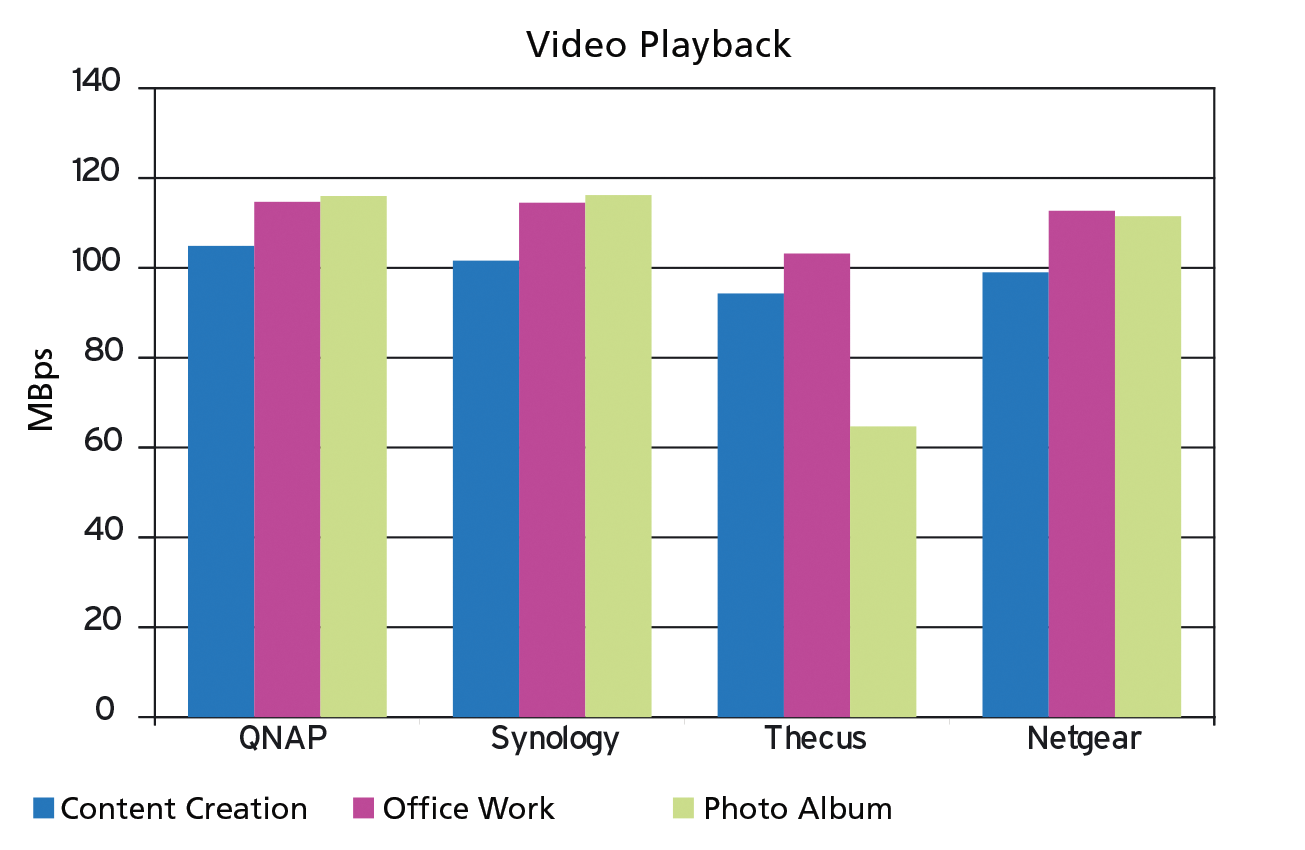
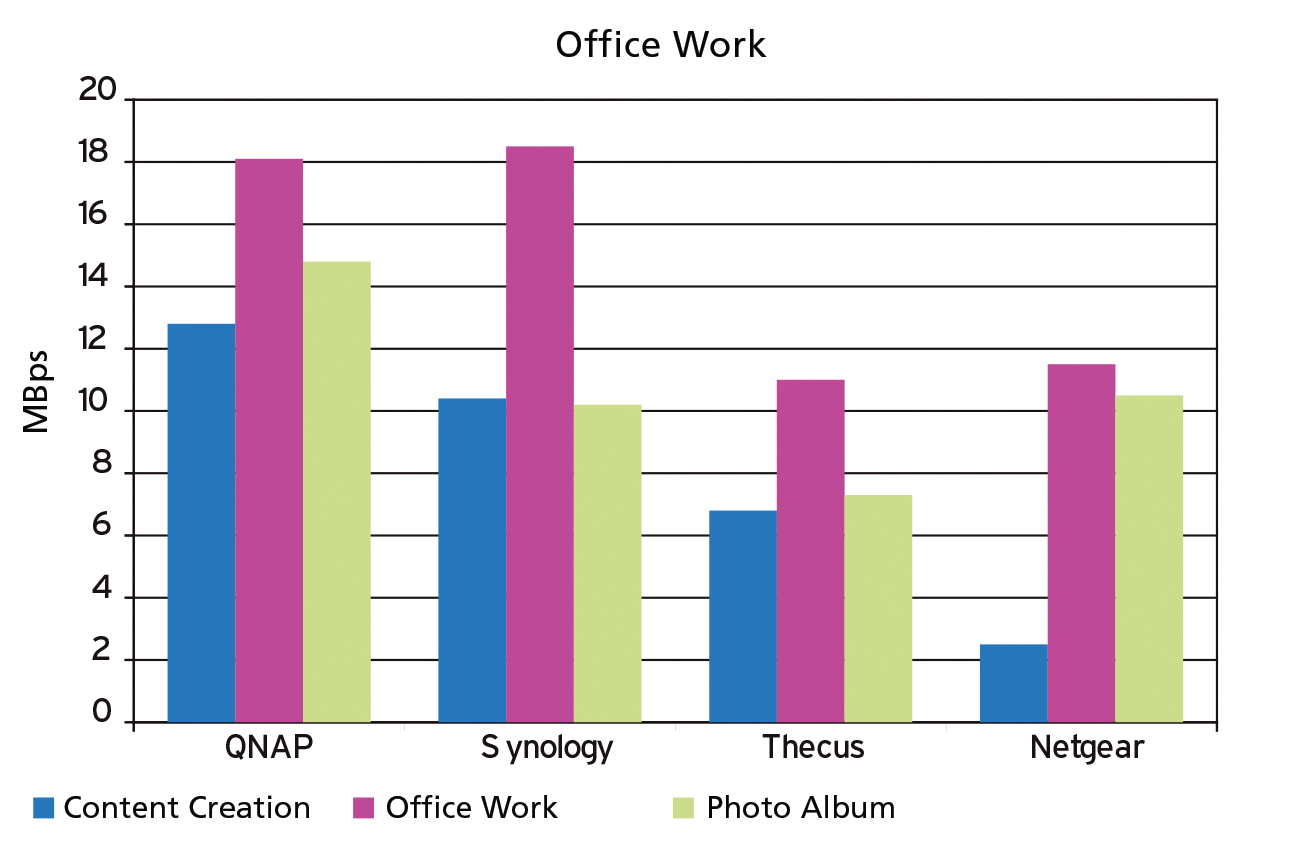
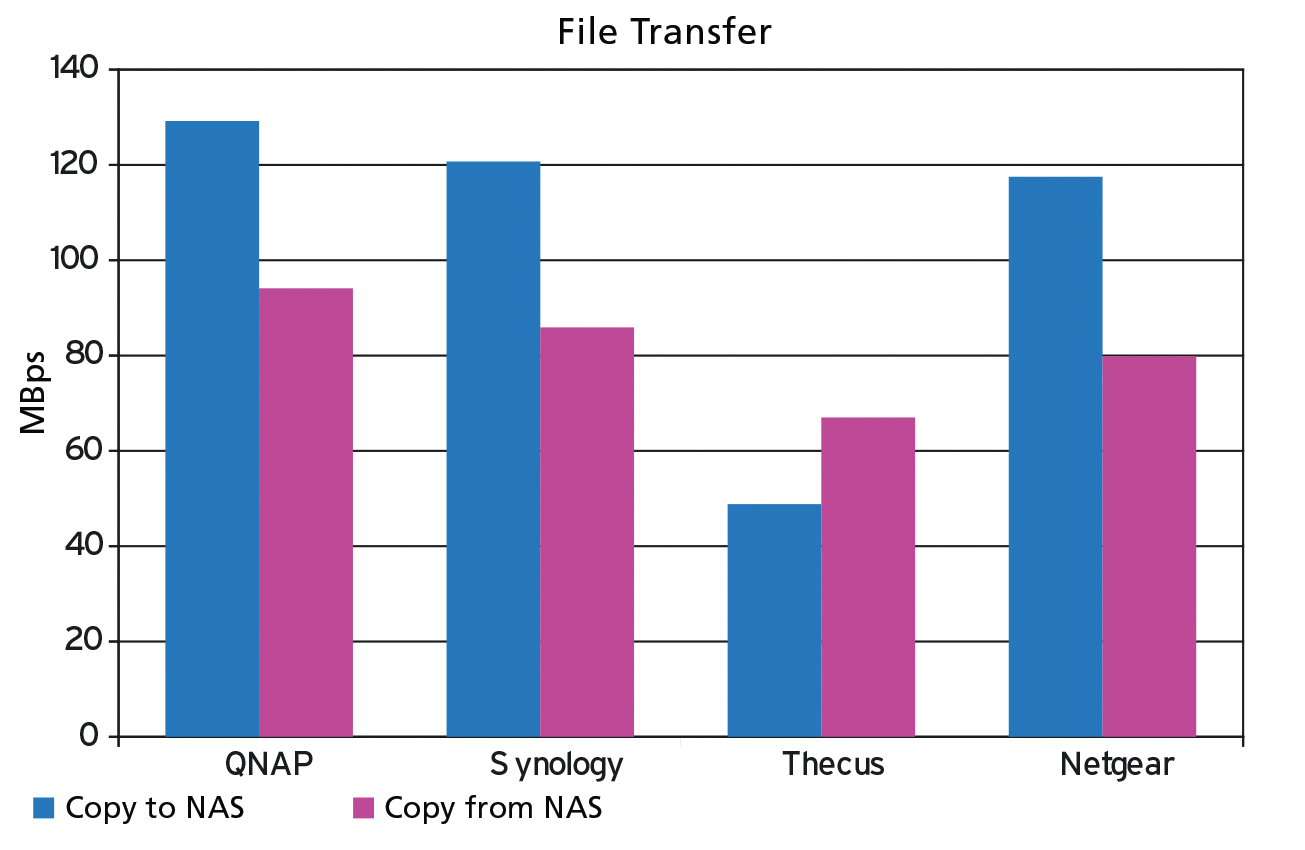
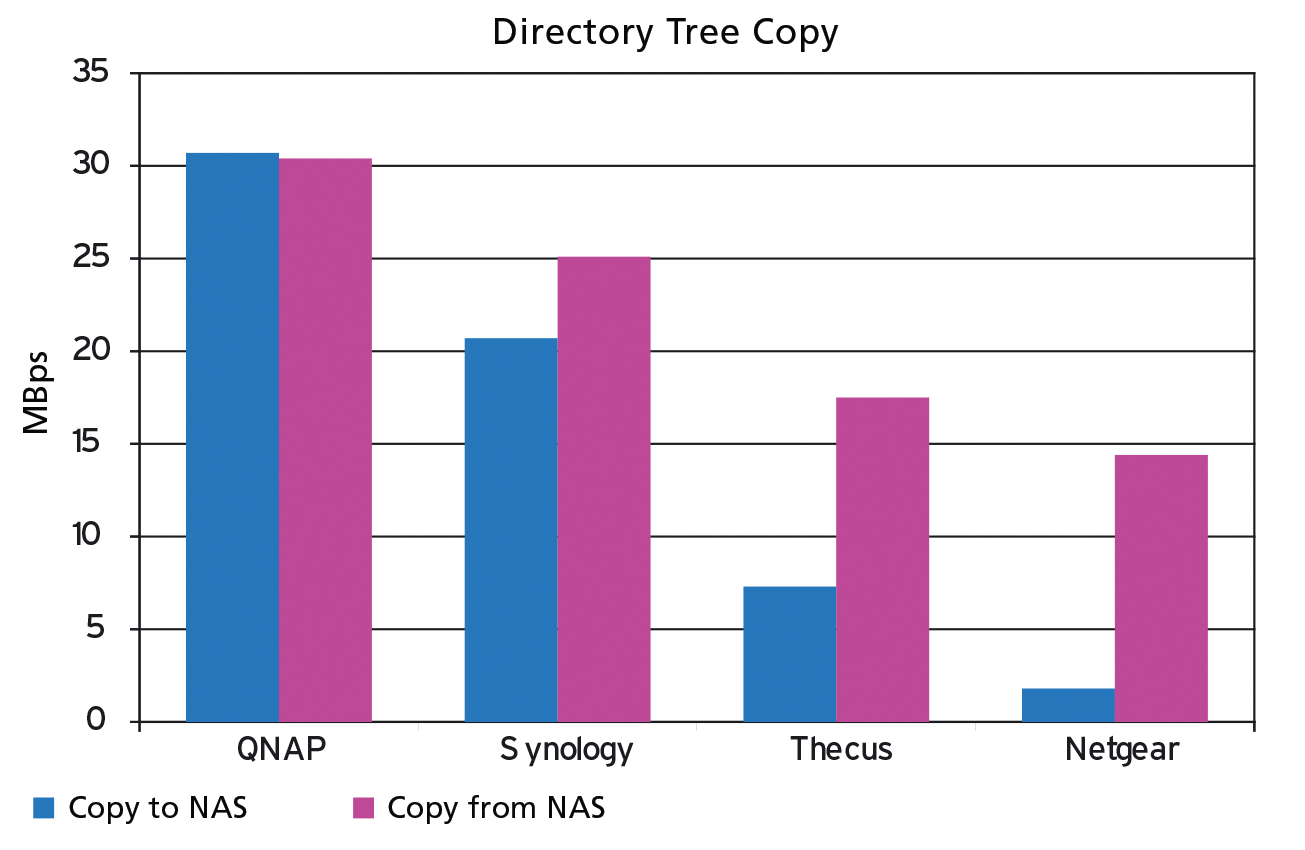
The NASPT aims to measure performance from the end user's perspective, which – instead of just running some purely synthetic benchmarks – does justice to caching effects at the operating system level and CPU performance. (See the "How We Tested" box for more details.)
CPU performance test results especially proved a decisive factor: The Atom CPU in the Thecus achieved a CPU Mark [2] value of 667, which is just around two-thirds of the performance of the Celeron CPU (1047 CPU Mark) in the QNAP device. This difference is reflected in the application performance – not so much with sequential streaming of large files, but with small block sizes, several users working at the same time, or frequent metadata changes. For example, CPU performance considerably influences transfer rates while copying directories (Figure 4). In contrast, sequential reads are predominant in video streaming playback, and the differences here are relatively small.
Private Cloud
The question is: Are these devices fit for operating a private cloud, in which you control your own data and also have the security side in your own domain? To answer this question, you first have to decide what you expect from such a cloud: just file storage? Or do you also want it to host business applications (e.g., mail and web servers, databases, a CMS, or groupware)? The second question is then: Which of these functions can be accessed using a mobile device outside of your own LAN?
The crux of the matter in answering the second question is that most NAS devices probably reside behind a NAT router; thus, they have a private IP address, which can be in use in thousands of places around the world and therefore not routed. To put it differently, the NAS is unreachable from the outside. With one or two small tricks, however, it could be.
Trick number one: The private address is only an obstacle when connecting from the outside because the sender cannot forward packets to a recipient with a private address. This is why the NAS initiates a connection from the inside to a server hosted by the NAS manufacturer. Here, the private address doesn't matter because the NAT router replaces it on sending with the registered IP address that it got from the Internet provider.
Anyone wanting to access the NAS on the private network from the outside does not directly contact the unit, but rather the server hosted by the vendor. To do so, you hand over an ID that lets the vendor identify the connection that the NAS has established with the vendor. As a result, this server distributes all the packages from and to the NAS via the two connections which the user and the NAS have established. The Thecus device does not offer this ability, however, and Netgear does not offer this option to Linux users.
Trick number two: Another option is to register the NAT router's IP address with a dynamic DNS (DDNS) service and configure port forwarding on your router. Users from the outside can then access, for example, the WebDAV port on the router under the hostname that is registered with the DDNS service, and then the router passes the data through to the NAS.
The second method is especially practical for services that communicate over a fixed port. It has actually nothing to do with NAS, except that some NAS manufacturers such as Synology operate DDNS services themselves and can also handle the router configuration using the Universal Plug and Play protocol introduced by Microsoft (UPnP). Both functions are integrated into the NAS GUI (Figure 5).
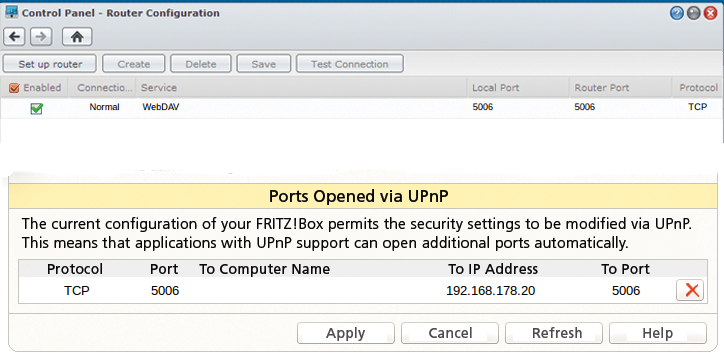
All NAS devices have a web server, which they need at least to serve up their management GUIs, if nothing else. Trick number two means that access to any CMS, CRM, ERP, or groupware applications, as well as wikis, webshops, or backup programs is easy, assuming they have a web interface. For CMS, this means Drupal (Synology, QNAP, Thecus, Netgear), WordPress (QNAP, Thecus, Netgear), Joomla (QNAP, Netgear), Alfresco (Thecus), or Serendipity (QNAP).
CRM applications such as SugarCRM (Synology) or Vtiger (Synology, QNAP, Thecus), ERP programs such as OpenERP (Synology, QNAP, Thecus, Netgear) or webERP (QNAP), and wikis like MediaWiki (QNAP, Netgear) or DokuWiki (Synology, QNAP, Netgear) are no problem. Access to everything else that has a web interface uses the same approach: groupware, stores, media servers, backup applications, and infrastructure components (VPN, DNS, DHCP, web server, mail server, etc.). Not all applications are available from any NAS; in case of doubt, take a look in the module list [3]-[6].
It is just as easy for users from outside to draw on the file server functionality of the NAS devices, be it via NFS, CIFS, AFP, WebDAV, or even FTP. There are extra control interfaces for these in part. Some manufacturers even offer extra apps for Android and iOS, so you can upload photos from your handycam to the NAS or download music from it. Often, apps are also available for synchronizing directories between mobile devices and the NAS. Finally, the NAS can be used as a storage cloud à la Dropbox – it either offers ownCloud, a proprietary application like ReadyDROP on the Netgear device, or both.
Performance Questions
Connectivity thus will not be the problem in most cases. However, you can definitely expect the devices with less powerful CPUs to be left behind, especially if many users are working on them in parallel. To demonstrate this, we used an Apache HTTP Server with the Ab benchmarking tool to fire 1,000 requests each at the web servers on the NAS devices – the task was simply to retrieve the Apache welcome page previously deposited on the NAS. We then increased the number of users working in parallel a step at a time and measured how many requests per second were possible five times for each level in the test. Afterward, we computed a mean value from the measurements.
As you can see, the scalability horizon is reached at about six users for all devices, with the performance curve more or less flatlining (Figure 6). Although this happens at different levels, not even the fastest device can cope with more than eight simultaneous users without reaching the saturation point. Note that this is not the maximum number of users you can serve; you can further increase the number of users before the performance starts to drop off again. This is the point at which more users can no longer access more pages at the same time. You could further increase the number of users asking for pages in parallel, but you won't get more pages from the web server.
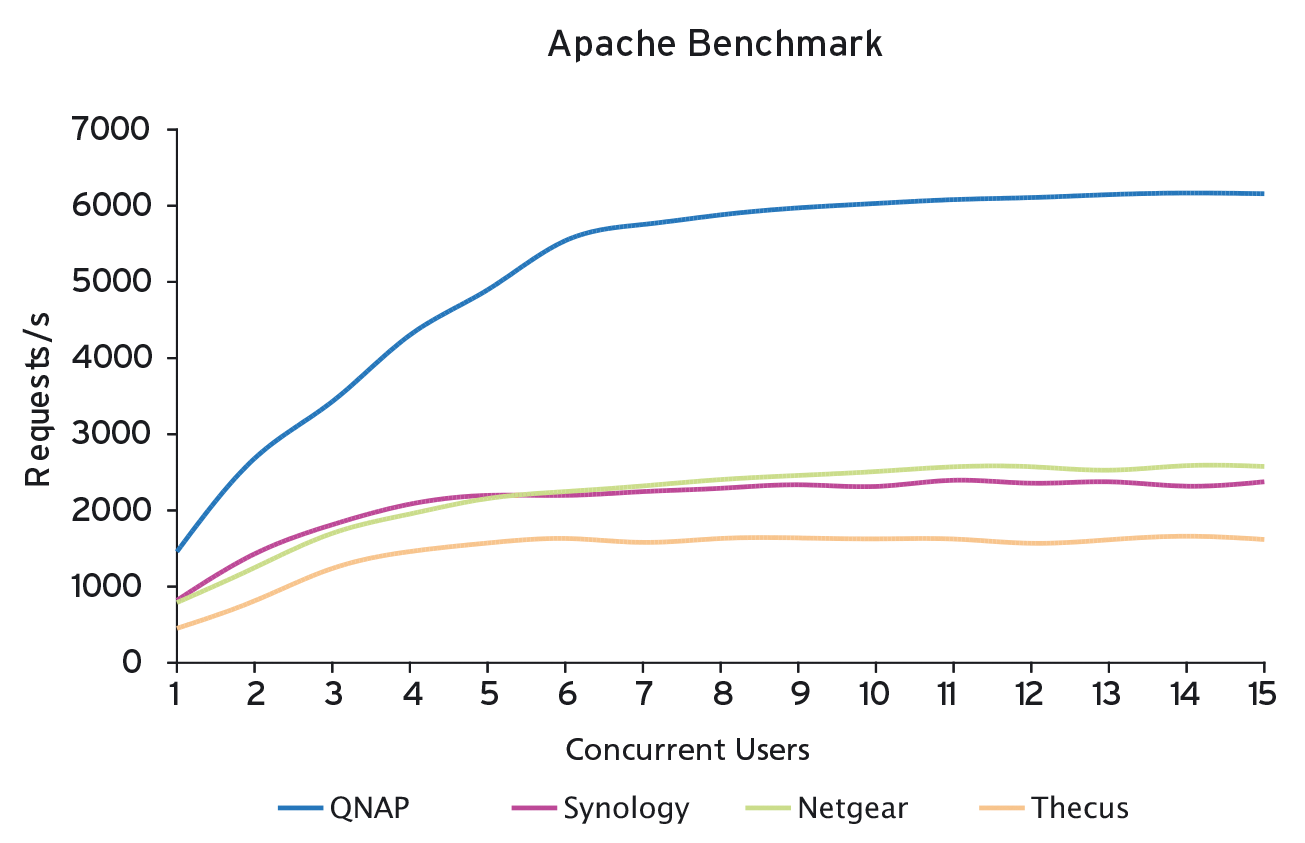
Conclusions
NAS devices today are no longer just data silos; they are small universal servers that offer all sorts of useful services: at home as media servers that serve up images, movies, and music and in a professional environment as servers for business applications, infrastructure services, and backup. If you don't overtax the limited computing power of the device, you can gain a useful helper with great potential for rationalizing operations. Another benefit for users is that you keep control over your data and still can access it from anywhere.
Before you purchase, take a close look at the price/performance ratio. Additionally, you will want to consider carefully what you really need. Maybe you don't need the fastest solution. Maybe Btrfs snapshots or a particular app are what attract you. In principle, anyone should be fine managing any of these devices without needing to be overly tech savvy.


